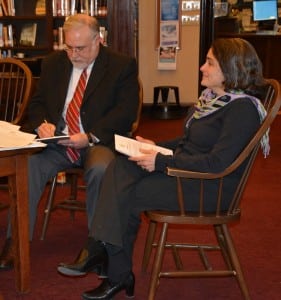Discussion peripherally mentions Horton Road project
By Liz Schevtchuk Armstrong
Philipstown’s Planning Board got a primer on conservation subdivisions and conservation easements last week (Thursday, Jan. 15), devoting a workshop to training on the related topics, important to aspects of town land use and zoning law.
Landscape architect Susan Jainchill of AKRF, the planning firm that advises the town government, and Andrew Chmar, executive director of the Hudson Highlands Land Trust, led the session.

No agenda was available before the meeting and although informally expected to include discussion of the proposed Hudson Highlands Reserve, the evening brought only peripheral mention of that project. Hudson Highlands Reserve is an upscale leisure and equestrian-oriented development proposed for 155.4 acres off Route 9 in northern Philipstown.
Under review by both the Planning Board and the Philipstown Conservation Board, it has been billed by its sponsors, Horton Road LLC, as a conservation subdivision, although the design presented last fall, featuring homes on large lots, raised questions about that description. The Hudson Highlands Reserve conservation subdivision application is the first since the adoption of a new town zoning code in 2011.
Thursday’s training was “something we’d been planning for a long time,” Planning Board Chairman Anthony D. “Ande” Merante noted in opening the workshop. Clearly, though, Horton Road LLC’s plans increase the relevance of Planning Board interest.
Conservation subdivisions
Jainchill walked the Planning Board through the ins and outs of its role, the zoning code and forms of cluster development, which include conservation subdivisions. In part, she explained how, in scrutinizing proposed projects, the Planning Board can refer to the town’s zoning code and Comprehensive Plan. “The town code comes from the comprehensive plan. The comprehensive plan is sort of the blueprint” and the code the regulatory tool, she said. Moreover, in Planning Board work, “you do not make the law, you apply the law,” she told the board members.
Cluster subdivisions group buildings together on a relatively small portion of the overall development, to preserve open space, including woods, and encourage walking and neighborhood-style activities — unlike typical suburban subdivisions that promote dominance of automobiles and sprawl and spread homes across the development.
A conservation subdivision “is a type of cluster subdivision,” but one with a higher ratio of open space to developed land than even the usual cluster community, according to Jainchill. In a conservation subdivision, the design accounts above all for the natural and cultural features of the land, she said. “It starts with that” and the buildings are located and constructed around the landscape, she said. “It’s responding to something other than just development values.”
She also observed that “probably one of the biggest reasons to live in this town — nature” and the desire to respect it — shaped the comprehensive plan. Incidentally, she pointed out, the Comprehensive Plan calls for preserving horse trails and encouraging creation of others, which presumably “is very applicable to” the Horton Road project.
Conservation easements
Chmar focused on what conservation easements are and what his organization, the Hudson Highlands Land Trust, does and does not do in regard to them. He prefaced his remarks by stating that he had wanted bring his presentation to the Planning Board for several years and that “it has nothing to do with this application” by Horton Road LLC as such.
Materials he provided included the definition from the New York State Environmental Conservation Law of a conservation easement: “an easement, covenant, restriction” or similar provision for property “which limits or restricts development” and entails “management or use of … [that] property for the purpose of preserving or maintaining [its] scenic, open, historic, archeological, architectural, or natural condition, character, significance, or amenities.” Conservation easements, which permanently restrict use of the land, prevent development and offer a public benefit, are overseen by an authorized land trust, such as the HHLT, or a government.

He said he often is asked why the HHLT wants to snatch private land. “We do not take land at all,” he emphasized. “What we take are the development rights — the future development rights on the property. That’s what we hold.” He further stated that “the owner continues to own the property subject to the easement and can sell it or transfer it to heirs with the conservation easement remaining in force through successive ownership.”
In establishing a conservation easement, a landowner can become eligible for a reduction in federal income taxes and might earn a New York state tax credit of up to $5,000 annually (as long as creation of the easement was not required for local government permission for a subdivision). But those are federal and state boons.
“Contrary to popular belief,” Chmar said, “a conservation easement donation does not typically reduce local property or school taxes [and] thus does not financially ‘harm’ the local municipality or school-district tax revenue.” Consequently, “our work does not affect the tax base in the Town of Philipstown,” he said. “Our work does not affect local property taxes.”
He also cautioned that controlling a conservation easement costs an organization monetarily and in staff resources. Sometimes, he said, overseeing one in a subdivision with multiple sets of documents and 28 or 29 separate homeowners/property-owners — like the Horton Road development could ostensibly have — brings a burden too heavy to bear. “I don’t think our organization would accept it,” he said.
Nor, in such cases, would a local government necessarily jump in, added Stephen Gaba, the Planning Board attorney. “Sometimes you have a situation where nobody wants the conservation easement” responsibilities, Gaba said.
Photos by L.S. Armstrong
